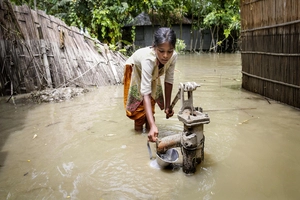UN Photo/G.M.B. Akash
Most disasters are water-related. Floods, landslides, storms, heat waves, wildfires, extreme cold, droughts and waterborne disease outbreaks are all becoming more frequent and more intense, mainly due to climate change.
The impacts of disasters are exacerbated by urbanization and degradation of natural environments. Improving the resilience of water and sanitation services and protecting ecosystems will be key to surviving a climatically uncertain future.
The issue explained
Most disasters are water-related and climate change is increasing their frequency and severity. Poor communities are more vulnerable to the impacts of disasters, widening inequalities and undermining sustainable development.
The impacts of disasters include loss of life and damage to water and sanitation infrastructure, such as waterpoints, wells, toilets and wastewater treatment facilities.
In the aftermath of disasters, infectious disease outbreaks are common due to the spread of sewage, the breakdown in water and sanitation services, and diminished ability to practise good hygiene.
The degradation of natural environments makes the impact of water-related disasters worse. Loss of natural ‘buffers’ such as trees, river bank-side vegetation, wetlands and coastal mangroves reduces protection from flooding.
Rapid urbanization can concrete over large areas of land, channelling run-off too rapidly into storm drains, quickly […]
Full article: Water and Disasters

